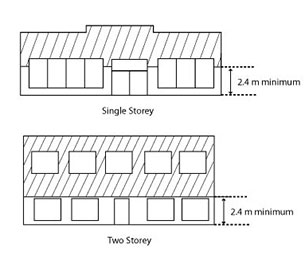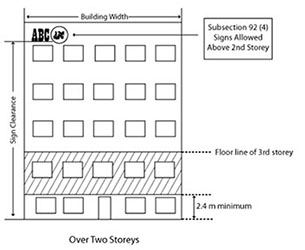Sign permits
Before you Apply
Use this page to help guide you through submitting a complete application. We will explain when you need a permit, what permits you need, what your application requirements are and go over some common rules relating to your project.
What type of sign do I need?
Basic signs (Class A)
Basic signs include address, art, banner, construction, directional, flag, gas bar, pedestrian, real estate, special event, show home, temporary, and window signs on private property.
Fascia signs (Class B)
A fascia sign is attached to, or marked on a building’s exterior wall. It typically displays the name or logo of a business or building and does not project more than 0.4 metres from the building wall.
Freestanding signs (Class C)
A freestanding sign is displayed on a permanent, non-moveable structure other than a building. It can display the name of a business or building, and can also display messaging.
Canopy and projecting signs (Class D)
A canopy sign is usually displayed on, under, or attached to a canopy or awning that’s fastened to an exterior building wall. A projecting sign is attached to the exterior building wall and is perpendicular to the building.
Digital message and other signs (Class E)
This category includes digital message, inflatable, painted wall, roof, rotating signs, and temporary sign markers.
In addition to the sign types listed here, any type of sign that doesn’t fit within any of the bylaw sign types, and doesn’t include a digital display, falls within the Class E category. Class E signs are located on the same site as the business/activity that they are advertising.
Third party advertising signs (Class F)
Third party advertising signs direct attention to a business, product or service that is available at a different location than where the sign is placed.
Digital third party advertising signs (Class G)
A digital third party advertising sign is a digital display that directs attention to a business, product or service that is available at a different location other than where the sign is placed.
Do you need a permit?
A development permit is not required to:
- Maintain or repair a legally existing sign
- Change or reduce the copy area of a legally existing sign
Basic signs (class A)
All types of signs that fall within the basic sign (Class A) category do not require a development permit when:
- They meet all the applicable rules
Fascia signs (Class B)
Fascia signs do not require a development permit when:
- Fascia signs (Sign - Class B) are a permitted use in the land use district;
- The sign area is not larger than 1.5 square metres; and
- The sign meets all applicable rules
In a case where a new fascia sign does not meet all applicable rules, a permit application may be considered with a relaxation to the rules. The process and fees are different in this case. Please view ‘How to apply’ to see the fees for an application with relaxations.
Freestanding signs (Class C)
Application, bylaws, and design regulations for all freestanding signs on private property
A freestanding sign is displayed on a permanent, non-moveable structure other than a building. It can display the name of a business or building, and can also display messaging.
Canopy and projecting signs (Class D)
All new canopy and projecting signs require a development permit.
In a case where a new canopy or projecting sign is a permitted use in the land use district but does not meet all applicable rules, a permit application may be considered with a relaxation to the rules. This affects the process and fees for the application. Please view ‘How to apply’ to see the fees for an application with relaxations.
A development permit is NOT required to:
- Maintain or repair a legally existing sign
- Change or reduce the copy area of a legally existing sign
Digital message and other signs (Class E)
All Class E signs require a development permit.
Third party advertising signs (Class F)
A development permit is required for all new and renewals of third party advertising signs.
Digital third party advertising signs (Class G)
A development permit is required for all new and renewals of digital third party advertising signs.
How much will it cost?
Rules
Rules for all signs
- The sign position, shape, colour, format or illumination cannot resemble a traffic sign, signal or any other traffic control device.
- Lights cannot be like those associated with danger or used by emergency services.
- Trees or shrubs must not be removed or damaged to install a sign, make a sign more visible, maintain a sign, or to change the copy.
- Signs in a residential area cannot be directly illuminated from a light source on the sign itself; however, they can be illuminated indirectly, such as a by a light shining on the sign. The light must not encroach onto adjacent spaces.
Rules for basic signs (class A)
Review the checklist and sign rules below
Rules for fascia signs (Class B)
Review the checklist and sign rules below.
One and two storey buildings
-
The designated area is anywhere between 2.4 metres above grade and the upper edge of the building

- No part of a sign can project beyond the shaded area
- The sign can cover a part of the window if it is 2.4 metres above grade
- A sign may be permitted under 2.4 metres if:
- It consists of individual letters, symbols, or logos that are directly attached to the building
- Any portion of the sign below the designated area does not exceed 30 per cent of the wall area
- The copy area is under 9.3 square metres
Buildings over two storeys
-
The designated area is anywhere between 2.4 metres above grade and the bottom of the third storey.

- A sign may be permitted above the second storey if:
- It consists of individual letters, symbols, or logos directly attached to the building
- There is only one sign per building face above the second storey
- The sign area does not exceed 2.5 per cent of the total area formed by multiplying the clearance of the sign from grade by the width of the building (see image)
Primary building wall
- No maximum sign area within the designated area
- No restrictions on the number of signs
- Can have multiple primary building walls
Secondary building wall
- Secondary building walls are any walls that are not primary building walls
- Maximum sign-able area is 30 per cent
- May be illuminated
- The sign must be indirectly illuminated if facing a park or adjacent property designated as residential
Rules for freestanding signs (Class C)
Review the checklist and sign rules below.
- The sign cannot interfere with vehicle parking or traffic circulation.
- All electrical power supplied to the sign must be underground.
- Anchor bolts securing the base of the sign must be permanently covered.
- A new freestanding sign must be located a minimum of 30 metres from any other freestanding sign on a neighbouring property which is facing the same oncoming traffic and is on the same side of the street.
Rules for canopy and projecting signs (Class D)
Review the checklist and sign rules below.
Rules for digital message and other signs (Class E)
Review the applicable checklist and sign rules below.
Rules for third party advertising signs (Class F)
Review the checklist and sign rules below.
Rules for digital third party advertising signs (Class G)
Review the checklist and sign rules below.
Prepare your application
| Building safety approval - development permit | Our process | Timeline |
|---|---|---|
| Application is reviewed to ensure it matches the approved development permit and reviewed for safety code compliance | 7 days |
When does your permit expire?
| Permit type | Expiry (from date of issuance) |
|---|---|
| Sign permit | 180 days |
You will receive a permit expiry reminder in the mail. If you need more time, you can extend your permit. Visit the extend or reinstate your permit page.
Do you need to hire a professional?
How to prepare your application
1. Prepare the application details
You will need to know:
- The project address
- Who is applying (the homeowner or someone representing the owner)
- Who will be doing the work (contractor, homeowner)
- What you are applying for
- Project details, including the size of the deck
2. Prepare the required documents and plans
Specific drawing and supporting document requirements are listed on the permit checklist (can be found under the Rules section). You must provide all the required drawings and documents when you submit your application.
What inspections do you need?
Development Completion Inspection
All discretionary signs and signs that require a relaxation of the Land Use Bylaw will need a development completion inspection to ensure the sign was installed in the correct location, and meets conditions of approval.
Development completion inspections can be booked through the Planning services centre.
How do you book your inspections?
Visit building inspections for information on how to book, cancel or reschedule an inspection, permit expiry and the requirements for each inspection type.

